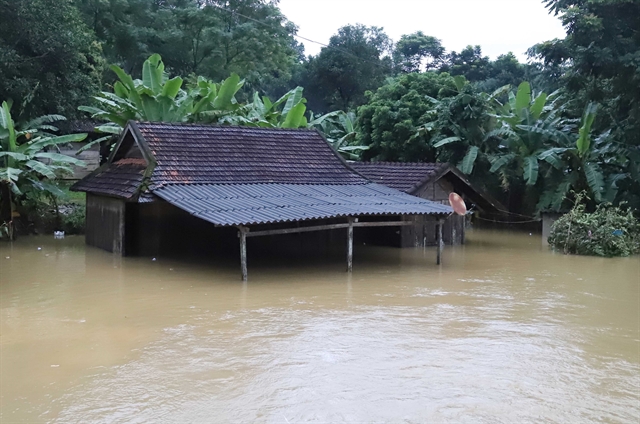 Society
Society

 |
| The water level nearly reached the roof of a house in Quỳ Châu District, Nghệ An Province on Wednesday. — VNA/VNS Photo Xuân Tiến |
NGHỆ AN — Multiple areas of the central Nghệ An Province have witnessed severe flooding and significant damage to property and agricultural production due to heavy downpours in recent days.
Owing to the effects of a tropical low-pressure system, multiple cities and provinces in the northern and central regions have experienced heavy rainfall, which exceeded 500mm in several areas.
Floods and landslides have been recorded in various locations, primarily in the provinces of Thanh Hóa, Nghệ An, Hà Tĩnh, and Quảng Bình.
According to reports from local authorities in Nghệ An, as of Wednesday evening, 22 points of inundation were recorded across national routes running through the localities, while 19 roads were closed.
Kỳ Sơn District evacuated 139 people, while 706 residents of Quế Phong District were isolated due to the heavy rain.
The province also reported flooding in 1,600 households and damage to 1,503ha of rice and 3,050ha of other crops. Nearly 2,400 cattle and poultry were killed during the flood.
A total of 1,615m of traffic routes were eroded.
Although the water level is receding, local authorities reported that risks remain, as over 300 irrigation lakes in the locality are now full.
Several hydropower plants in the area are also planning to discharge water from their reservoirs as the water level has exceeded the limit.
Nghệ An Province has instructed proactive planning for safe operations, especially at crucial dams.
Localities will also need to closely monitor and guide traffic around ferry wharves and inundated or eroded routes to ensure safety for the people and will carry out evacuations for residents in at-risk areas.
Prime Minister’s dispatch
Prime Minister Phạm Minh Chính on Thursday signed an official dispatch on mitigating the effects of heavy downpours and flooding.
The National Steering Committee for Natural Disaster Prevention and Control is responsible for responding to incidents and conducting search and rescue operations. In addition, ministers and ministerial-level leaders must closely monitor the situation and implement effective measures.
The committee will also collaborate with the ministries of National Defence and Public Security to ensure prompt and effective search and rescue operations and disaster responses.
Chairpersons of the Provincial People’s Committees are required to review and evacuate people from at-risk regions promptly, especially those in areas with a high likelihood of flash floods and landslides.
Essential items and food should be provided to those affected by the heavy downpours. Safety measures must be implemented for buildings under construction, as well as for dams and reservoirs.
The Ministry of Natural Resources and Environment has the responsibility of issuing timely and comprehensive forecasts and warnings about heavy rain, erosion, and flash floods for authorities and localities.
The Ministry of Transport will provide direction and guidelines for routing traffic, ensuring safety in areas impacted by the downpours. They will also mobilise human resources and equipment in the event of incidents to maintain traffic flow, especially on key routes.
The ministries of agriculture and rural development, industry and trade, and health will collaborate to support people and production and prevent the spread of diseases due to rain and floods. — VNS




